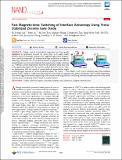| dc.contributor.author | Tan, Aik Jun | |
| dc.contributor.author | Huang, Mantao | |
| dc.contributor.author | Beach, Geoffrey Stephen | |
| dc.date.accessioned | 2020-09-09T11:15:45Z | |
| dc.date.available | 2020-09-09T11:15:45Z | |
| dc.date.issued | 2020-04 | |
| dc.date.submitted | 2020-04 | |
| dc.identifier.issn | 1530-6984 | |
| dc.identifier.uri | https://hdl.handle.net/1721.1/127206 | |
| dc.description.abstract | © 2020 American Chemical Society. Voltage control of interfacial magnetism has been greatly highlighted in spintronics research for many years, as it might enable ultralow power technologies. Among a few suggested approaches, magneto-ionic control of magnetism has demonstrated large modulation of magnetic anisotropy. Moreover, the recent demonstration of magneto-ionic devices using hydrogen ions presented relatively fast magnetization toggle switching, tsw ∼100 ms, at room temperature. However, the operation speed may need to be significantly improved to be used for modern electronic devices. Here, we demonstrate that the speed of proton-induced magnetization toggle switching largely depends on proton-conducting oxides. We achieve ∼1 ms reliable (>103 cycles) switching using yttria-stabilized zirconia (YSZ), which is ∼100 times faster than the state-of-the-art magneto-ionic devices reported to date at room temperature. Our results suggest that further engineering of the proton-conducting materials could bring substantial improvement that may enable new low-power computing scheme based on magneto-ionics. | en_US |
| dc.description.sponsorship | Korea Institute of Science and Technology Institutional Program (Grant 2E29410, 2E30220) | en_US |
| dc.description.sponsorship | National Research Councilof Science and Technology (Korea) (Grant CAP-16-01-KIST) | en_US |
| dc.description.sponsorship | National Science Foundation (U.S.) (Awards DMR-1419807, ECCS-1808828) | en_US |
| dc.language.iso | en | |
| dc.publisher | American Chemical Society (ACS) | en_US |
| dc.relation.isversionof | 10.1021/acs.nanolett.0c00340 | en_US |
| dc.rights | Creative Commons Attribution-NonCommercial-NoDerivs License | en_US |
| dc.rights.uri | http://creativecommons.org/licenses/by-nc-nd/4.0/ | en_US |
| dc.source | ACS | en_US |
| dc.title | Fast magneto-ionic switching of interface anisotropy using yttria-stabilized zirconia gate oxide | en_US |
| dc.type | Article | en_US |
| dc.identifier.citation | Lee, Ki-Young et al. “Fast magneto-ionic switching of interface anisotropy using yttria-stabilized zirconia gate oxide.” Nano Letters, 20, 5 (April 2020): 3435−3441 © 2020 The Author(s) | en_US |
| dc.contributor.department | Massachusetts Institute of Technology. Department of Materials Science and Engineering | en_US |
| dc.relation.journal | Nano Letters | en_US |
| dc.eprint.version | Final published version | en_US |
| dc.type.uri | http://purl.org/eprint/type/JournalArticle | en_US |
| eprint.status | http://purl.org/eprint/status/PeerReviewed | en_US |
| dc.date.updated | 2020-09-02T18:38:00Z | |
| dspace.date.submission | 2020-09-02T18:38:03Z | |
| mit.journal.volume | 20 | en_US |
| mit.journal.issue | 5 | en_US |
| mit.license | PUBLISHER_CC | |
| mit.metadata.status | Complete | |
